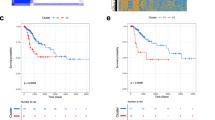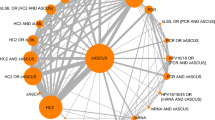Abstract
Particular types of human papillomavirus (HPV) infection may preferentially progress from high-grade squamous intraepithelial lesions (HSIL) to squamous cell carcinoma of the cervix (SCC). We performed a meta-analysis of published data to compare HPV type distribution in HSIL and SCC. HPV16, 18 and 45 were each more prevalent in SCC than HSIL, whereas the reverse was true for other oncogenic types including HPV31, 33, 52 and 58. These data suggest that HSILs infected with HPV16, 18 and 45 preferentially progress to SCC. This may have implications for follow-up protocols of future HPV-based cervical cancer screening programmes and for HPV vaccine trials.
Similar content being viewed by others
Main
Epidemiological studies have established human papillomavirus (HPV) infection as the central cause of invasive cervical cancer (ICC) and its precursor lesions (Walboomers et al, 1999). However, only a fraction of precancerous lesions progress to ICC. A strong candidate factor for differential progression is HPV type (Lorincz et al, 1992).
Identifying HPV types that preferentially progress from high-grade squamous intraepithelial lesions (HSIL) to ICC has implications not only for follow-up protocols in ICC screening programmes, but also for prophylactic type-specific HPV vaccine trials. For ethical reasons, final outcome measures in such trials will be the prevention of HSIL. However, it is important to know whether the HPV type distribution in HSIL is representative of those that go on to cause cancer.
Articles presenting HPV type-specific prevalence data were identified from Medline. Studies had to include at least 20 cases of squamous cell or histologically unspecified cervical cancer (Clifford et al, 2002) and/or 20 histologically verified cases of HSIL. In this study, HSIL refers both to lesions classified by the Bethesda system, that is, CIN2/3, and those classified separately as CIN2 and CIN3. Studies had to use polymerase chain reaction (PCR)-based assays to identify HPV, and to present prevalence of at least one type other than HPV6, 11, 16 or 18 (Clifford et al, 2002).
This report includes 8594 squamous cell carcinoma of the cervix (SCC) cases (including 2725 of unspecified histology), as previously reported in Clifford et al (2002), and 4338 HSIL cases (1733 reported as CIN2/3, 1824 as CIN3, 729 as CIN2 and 52 as cervical carcinoma in situ)(detailed information on the HSIL studies is reported in the Appendix). Compared to SCC, cases of HSIL were more likely to be from (i) Europe and South/Central America rather than other regions, (ii) studies that detected HPV from exfoliated cells rather than biopsy specimens and (iii) studies that used ‘broad’-spectrum (MY09/11, GP5+/6+ and SPF10) rather than other PCR primers (Table 1).
Type-specific prevalence is presented for the 14 most common high-risk (HR) types identified in SCC (Table 2). As not all studies tested for all 14 types, sample size varies between type-specific analyses. Type-specific prevalence is expressed as a percentage of all cases tested for HPV, and thus represents the prevalence in either single or multiple infections.
Overall, HPV prevalence was slightly higher in SCC cases (87.6%) than HSIL (84.2%) (SCC : HSIL ratio 1.04, 95% CI 1.03–1.06) (Table 2). HPV16 was the most common type in both SCC (54.3%) and HSIL (45.0%), but was more prevalent in SCC (ratio of 1.21, 95% CI 1.16–1.26). HPV18 was also more prevalent in SCC (12.6%) than in HSIL (7.0%), with a ratio of 1.79 (95% CI 1.56–2.10). HPV45 was associated with a ratio of 1.85 (95% CI 1.35–2.91), similar to that of HPV18. All other HR types included in the analysis had ratios between 0.1 and 0.6 (Table 2).
The SCC : HSIL ratios for the eight most common HPV types were additionally calculated within more homogeneous study subgroups: (i) studies that did not report any multiple infections (6558 SCC, 2182 HSIL), (ii) studies testing for HPV from biopsies (7128 SCC, 1483 HSIL) and (iii) studies using ‘broad’-spectrum PCR primers (5318 SCC, 3502 HSIL). The SCC : HSIL ratios were also calculated separately for HSILs classified by the Bethesda system and for CIN3 only. Across all these subanalyses, SCC : HSIL ratios remained consistent for HPV16 (range: 1.04–1.25), HPV18 (1.46–1.93) and HPV45 (1.20–4.61). HPV31, 33, 35, 52 and 58 were consistently associated with ratios of 0.3–0.9, with the exception of HPV58 for biopsy studies (1.06, 95% CI 0.73–2.08).
Where sample size permitted, subanalyses were also stratified by region. When estimated from studies within Asia, Europe and South/Central America, respectively, there was no material difference in SCC : HSIL ratios for HPV16 (1.46, 1.17, 1.40), HPV18 (1.74, 2.02, 1.46), HPV45 (4.35, 1.39, 1.20), HPV33 (0.56, 0.62, 0.76), HPV52 (0.39, 0.26, 0.64) or HPV58 (0.55, 0.24, 0.30). However, notably high ratios were observed for HPV31 in South/Central America (1.13, 95% CI 0.84–1.70) in comparison to Europe (0.41, 95% CI 0.36–0.48) and Asia (0.43, 95% CI 0.31–0.68), and for HPV58 in China (including Taiwan and Hong Kong) (1.27, 95% CI 0.85–2.51) in comparison to non-Chinese Asian countries (0.37, 95% CI 0.27–0.58), raising the possibility of localised variation in the malignant potential of particular HPV types (Chan et al, 2002).
Our findings suggest that worldwide, HSIL infected with HPV16, 18 or 45 are more likely to progress to SCC than HSIL infected with other HR types. This could be interpreted in two ways: either these types have a greater potential to induce fully malignant transformation, and/or these infections somehow preferentially evade the host immune system. Compared to other HPV types, HPV18 has been associated with increased oncogenic potential in cell culture, screening failures and poorer cancer prognosis (Hildesheim et al, 1999; Schwartz et al, 2001; Woodman et al, 2003). Thus, HPV18 enrichment in SCC may reflect its greater oncogenic potential. Given its genetic similarity to HPV18, this may also be true for HPV45. Conversely, compared to other HPV types, HPV16 infections are more likely to persist and progress to HSIL (Molano et al, in press). Both persistence of infection and progression to HSIL have been shown associated with HPV16 variants (Londesborough et al, 1996). Thus, HPV16 enrichment in SCC may be related to its greater ability to escape immune surveillance compared to other types.
Even in countries with established screening programmes, women still die from rapidly progressing cancers that escape periodic examination. Given that HPV16, 18 and 45 appear to have greater progressive potential, and in the event that future cervical screening programmes include HPV typing, women infected with HPV16, 18 and 45 may require closer surveillance than women infected with other HR HPV types.
The demonstration that the HPV type distribution in HSIL is not entirely representative of those that go on to cause cancer also has important implications for prophylactic type-specific HPV vaccine evaluation. This is because any beneficial effect identified by randomised trials from the proportion of HSIL preventable by HPV16 or HPV16/18 vaccines may be an underestimate of the beneficial effect on the prevention of ICC.
Change history
16 November 2011
This paper was modified 12 months after initial publication to switch to Creative Commons licence terms, as noted at publication
References
Chan PK, Lam CW, Cheung TH, Li WW, Lo KW, Chan MY, Cheung JL, Cheng AF (2002) Association of human papillomavirus type 58 variant with the risk of cervical cancer. J Natl Cancer Inst 94: 1249–1253
Clifford GM, Smith JS, Plummer M, Munoz N, Franceschi S (2002) Human papillomavirus types in invasive cancer worldwide: a meta-analysis. Br J Cancer 88: 63–73
Hildesheim A, Hadjimichael O, Schwartz PE, Wheeler CM, Barnes W, Lowell DM, Willett J, Schiffman M (1999) Risk factors for rapid-onset cervical cancer. Am J Obstet Gynecol 180: 571–577
Londesborough P, Ho L, Terry G, Cuzick J, Wheeler C, Singer A (1996) Human papillomavirus genotype as a predictor of persistence and development of high-grade lesions in women with minor cervical abnormalities. Int J Cancer 69: 364–368
Lorincz AT, Reid R, Jenson AB, Greenberg MD, Lancaster W, Kurman RJ (1992) Human papillomavirus infection of the cervix: relative risk associations of 15 common anogenital types. Obstet Gynecol 79: 328–337
Molano ML., van den Brule AJC, Plummer M., Weiderpass E, Posso H, Arslan A, Meijer CJLM, Muñoz N, Franceschi S, the HPV Study Group (in press) Determinants of clearance of HPV infections in women with normal cytology from Colombia. A population-based five-year follow-up study. Am. J. Epidemiol
Schwartz SM, Daling JR, Shera KA, Madeleine MM, McKnight B, Galloway DA, Porter PL, McDougall JK (2001) Human papillomavirus and prognosis of invasive cervical cancer: a population-based study.J Clin Oncol 19: 1906–1915
Walboomers JM, Jacobs MV, Manos MM, Bosch FX, Kummer JA, Shah KV, Snijders PJ, Peto J, Meijer CJ, Munoz N (1999) Human papillomavirus is a necessary cause of invasive cervical cancer worldwide. J Pathol 189: 12–19
Woodman CBJ, Collins S, Rollason TP, Winter H, Bailey A, Yates M, Young LS (2003) Human papillomavirus 18 and rapidly progressing cervical intraepithelial neoplasia. Lancet 361: 40–43
Acknowledgements
The work reported in this paper was undertaken by Dr Gary Clifford during the tenure of an IARC Postdoctoral Fellowship from the International Agency for Research on Cancer. We thank Dr Massimo Tommasino for his critical comments during the preparation of the manuscript.
Author information
Authors and Affiliations
Corresponding author
Appendix
Appendix
Study methods and type-specific prevalence of human papillomavirus by study and by region are summarised in Table A1
Rights and permissions
From twelve months after its original publication, this work is licensed under the Creative Commons Attribution-NonCommercial-Share Alike 3.0 Unported License. To view a copy of this license, visit http://creativecommons.org/licenses/by-nc-sa/3.0/
About this article
Cite this article
Clifford, G., Smith, J., Aguado, T. et al. Comparison of HPV type distribution in high-grade cervical lesions and cervical cancer: a meta-analysis. Br J Cancer 89, 101–105 (2003). https://doi.org/10.1038/sj.bjc.6601024
Received:
Revised:
Accepted:
Published:
Issue Date:
DOI: https://doi.org/10.1038/sj.bjc.6601024
Keywords
This article is cited by
-
HPV pathogenesis, various types of vaccines, safety concern, prophylactic and therapeutic applications to control cervical cancer, and future perspective
VirusDisease (2023)
-
Identification and characterization of the genome of a papillomavirus from skin lesions of four-toed hedgehogs (Atelerix albiventris)
Virus Genes (2023)
-
Differential proteomics reveals overexpression of ferroptosis-related proteins in cervical cancer tissue
Journal of Proteins and Proteomics (2023)
-
Hsp90 up-regulates PD-L1 to promote HPV-positive cervical cancer via HER2/PI3K/AKT pathway
Molecular Medicine (2021)
-
National genotype prevalence and age distribution of human papillomavirus from infection to cervical cancer in Japanese women: a systematic review and meta-analysis protocol
Systematic Reviews (2021)



